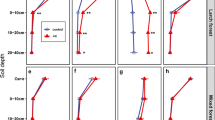Abstract
Decreased forest tree growth has often been attributed to increasing soil acidification, especially from high concentrations of soluble Al3+ and low base saturation. The growth of willow cuttings (Salix viminalis L. 78183) and Norway spruce seedlings (Picea abies L. Karst) were measured in a greenhouse in the presence of variable Ca2+ at uniform NH +4 concentrations. Sets of willows were grown in sand culture, one watered with Ingestad's nutrient solution (INS, pH 5.4) and the other watered with acidified Ingestad's nutrient solution (NSA, pH 3.8). Three levels of Ca2+ and Al3+ concentrations (in NSA only) were established for all nutrient solutions. Sets of Norway spruce seedlings were grown in calcareous sand and watered with INS, one of pH 5.4 and the other of pH 2.1 (resulting in two Ca2+ concentrations after acid neutralization by CaCO3). In the field, observations were made on the correlation of naturally occurring soil solution Al3+ and Ca2+ to spruce needle Al, Ca2+ and N concentrations. In the willow studies, both the above- and below-ground biomass were negatively influenced by the presence of Al3+. Aluminium decreased the growth of rooted cuttings (more in roots than shoots), reduced the uptake of N, Ca2+, Mg2+ and P, significantly lowered the weight of fine roots, and caused overall reductions of tissue nutrient concentrations. As Al3+ concentrations increased, increased concentrations of Ca2+ were needed by the willow to help ameliorate the effects of Al3+. In field samples of spruce needles and soil, CAB (CAB = Log10 Ca2+ /Al3+) was positively correlated with N concentration. From a combination of greenhouse and field studies the mechanisms for Ca2+ amelioration of Al3+ toxicity in trees appear to be i) the effect of Ca2+ on reduced absorption of Mn2+ and Al3+, ii) the effects of Ca2+ on NH +4 and P absorption, iii) and the stimulation of tree growth.
Similar content being viewed by others
References
Alva AK, Edwards DG, Asher CJ and Blamey FPC (1986) Effects of phosphorus/aluminum molar ratio and calcium concentration on plant response to aluminum toxicity. Soil Sci Soc Am J 50: 133–137
Andersson F (1989) Air pollution impact on Swedish forests - Present evidence and future development. Environmental Monitoring and Assessment 12: 29–38
Bengtsson B, Asp A, Jensen P and Berggren D (1988) Influence of aluminum on phosphate and calcium uptake in beech (Fagus sylvatica) grown in nutrient solution and soil solution. Physiol Plant 74: 299–305
Epstein E (1961) The essential role of calcium in selective cation transport by plant cells. Plant Physiol 36: 437–444
Fenn LB, Miyamoto S and Gobran G (1987) Guayule seedling response to nitrogen fertilizers. Fert Res 11: 113–121
Fenn LB, Taylor RM and Horst GL (1987)Phaseolus vulgaris growth in an ammonium-based nutrient solution with variable calcium. Agron J 79: 89–91
Fenn LB, Taylor RM and Pety Jr CA (1987) Stimulative effects of elemental sulfur in the presence of ammonium on chile and broccoli growth in calcareous soils. J Plant Nutr 10: 2263–2281
Foy CD (1978) The physiology of metal toxicity in plants. Ann Rev Plant Physiol 29: 511–566
Horst GL, Fenn LB and Beadle NB (1985) Bermudagrass turf responses to nitrogen sources. J Am Soc Hort Sci 110: 759–761
Ingestad T (1979) Mineral nutrient requirements ofPinus sylvestris andPicea abies seedlings. Plant Physiol 45: 373–380
Ingestad T and Kähr M (1985) Nutrition and growth of coniferous seedlings at varied relative nitrogen addition rate. Physiol Plant 65: 109–116
Jacobson L, Moore DP and Hannapel RJ (1959) Role of calcium in absorption of monvalent cations. Plant Physiol 35: 352–358
Kinraide TB and Parker DR (1987) Cation amelioration of aluminum toxicity in wheat. Plant Physiol 83: 546–551
Kramer PJ and Kozlowski TT (1960) Physiology of Trees. McGraw-Hill Book Co. New York
Krasaesindhu P and Sims JL (1972) Response of rice to nitrogen and calcium nutrition. Soil Sci Soc Am Proc 37: 457–460
Noble AD and Sumner ME (1988) Calcium and aluminum interactions and soybean growth in nutrient solutions. Commun Soil Sci Plant Anal 19: 1119–1131
Persson H (1979) Fine-root production, mortality and decomposition in forest ecosystem. Vegetation 41: 101–109
Rhue RD and Grogan CO (1977) Screening corn for aluminum tolerance. In: Wright MJ and Ferrari SA (eds) Plant Adaptation to Mineral Stress in Problem Soils, pp 297–310. Special publ Cornell Univ Agric Exp Stn, Ithaca, NY
Roberts TM, Skeffington RA and Blank LW (1989) Cause of type I spruce decline in Europe. Forestry 62: 179–222
Statistical Analysis System (SAS) Institute Inc. SAS users guide: Statistics. Version 5th Edition. Cary, NC
Sucoff E, Thornton FC and Joslin JD (1990) Sensitivity of tree sandlings to aluminum: I. Honeylocust. J Environ Qual 19: 163–171
Taylor RM, Fenn LB and Horst GL (1985) The influence of calcium on growth of selected vegetable species in the presence of ammonium nitrogen. J Plant Nutr 8: 1013–1023
Ulrich B (1983) Soil acidity and its relation to acid deposition In: Ulrich B and Pankrath J (eds) Effects of Accumulation of Air Pollutants in Forest Ecosystems, pp 126-146. D. Reidel Publishing Company
Van Praag HJ, Weissen F, Sougnez-Remy S and Carletti G (1985) Aluminum effects on spruce and beach seedlings. II. Statistical analysis of sand culture experiments. Plant Soil 83: 339–356
Viets Jr. F (1944) Calcium and other polyvalent cations as accelerators of ion accumulation by excised barley roots. Plant Physiol 19: 466–480
Zhao X, Sucoff E and Stadelmann EJ (1987) Al3+ and Ca2+ alterations of membrane permeability ofQuercus rubra root cortex cells. Plant Physiol 83: 159–162
Zoette HW (1983) Zur frageder toxischen Wirkung von Aluminum auf Pflanzen. Alig Forstz 38: 206–208
Author information
Authors and Affiliations
Rights and permissions
About this article
Cite this article
Gobran, G.R., Fenn, L.B., Persson, H. et al. Nutrition response of Norway spruce and willow to varying levels of calcium and aluminium. Fertilizer Research 34, 181–189 (1993). https://doi.org/10.1007/BF00750113
Received:
Accepted:
Issue Date:
DOI: https://doi.org/10.1007/BF00750113




